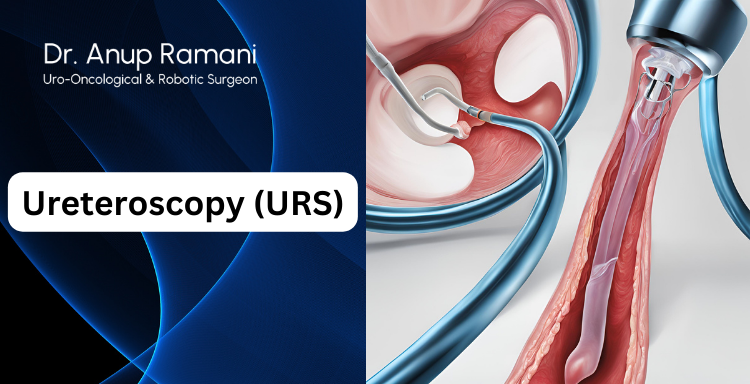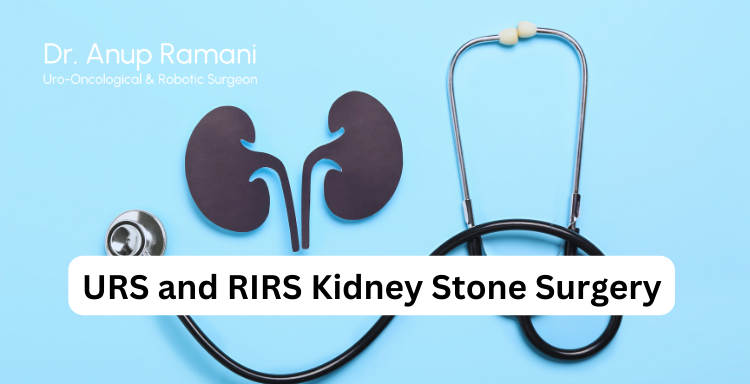Dr Anup Ramani @ Copyright 2024
By Dr. Anup Ramani
1. Introduction
Kidney stones can be an incredibly painful experience, often requiring medical intervention to remove them. If you’re facing kidney stone surgery, two common procedures you may encounter are URS (Ureteroscopy) and RIRS (Retrograde Intrarenal Surgery). These Minimal invasive surgeries are highly effective in treating kidney stones that cannot pass on their own. In this guide, we’ll walk you through everything you need to know about URS and RIRS, from preparation to recovery, so you can feel confident and prepared for your surgery.
2. Understanding Kidney Stones
Kidney stones are hard deposits of minerals and salts that form inside your kidneys. They can range in size from a grain of sand to a golf ball. Common symptoms include severe pain in the back or side, blood in the urine, nausea, and frequent urination. Risk factors for kidney stones include dehydration, a diet high in sodium, obesity, and certain medical conditions like gout or hyperparathyroidism.
3. Overview of Kidney Stone Treatment Options
Not all kidney stones require surgery. Smaller stones can often pass through the urinary tract on their own with the help of hydration and medications. However, when stones are too large, cause infection, or block the urinary tract, surgical intervention becomes necessary. This is where URS and RIRS come into play, offering Minimal invasive options to remove these stones.
4. What is URS (Ureteroscopy)?
URS, or ureteroscopy, is a procedure used to remove stones located in the ureter, which is the tube that connects the kidney to the bladder. During URS, a small scope is inserted into the urethra, passed through the bladder, and into the ureter to locate and remove the stone. URS is typically recommended for stones lodged in the lower urinary tract or smaller stones in the kidney.

5. What is RIRS (Retrograde Intrarenal Surgery)?
RIRS is a similar procedure but focuses on stones located higher up in the kidney. It involves using a flexible ureteroscope that can navigate through the urinary tract and into the kidney itself. Once the stone is found, it can be broken down using a laser and removed. RIRS is ideal for patients with stones that are too large to pass naturally or for stones located in the kidney.

6. Preparing for URS and RIRS
Before your surgery, your doctor will conduct a thorough evaluation, including blood tests, urine tests, and imaging studies like CT scans or ultrasounds to determine the size and location of the stones. You may need to follow specific pre-surgery instructions, such as fasting or adjusting certain medications. Hydration is key, so be sure to drink plenty of water leading up to the procedure, as this helps maintain kidney function.
7. What to Expect During URS Surgery
URS surgery is typically performed under general anesthesia, so you will be asleep throughout the procedure. The surgeon will insert the ureteroscope into the urethra, navigating through the bladder and into the ureter. Once the stone is located, it can be extracted with a small basket or broken up using a laser. The procedure usually takes about 30 to 90 minutes, depending on the complexity of the case.
8. What to Expect During RIRS Surgery
RIRS surgery is also done under general anesthesia. The flexible ureteroscope is carefully inserted through the urinary tract and into the kidney. Using a laser, the surgeon will fragment the kidney stones into smaller pieces, which can then be either extracted or allowed to pass naturally through the urine. RIRS typically takes about 1 to 2 hours, depending on the size and number of stones.
9. Potential Risks and Complications of URS and RIRS
Both URS and RIRS are considered safe, but as with any surgery, there are potential risks. Common risks include bleeding, infection, or injury to the urinary tract. In rare cases, patients may experience a ureteral stricture, where scar tissue narrows the ureter. Your surgeon will discuss these risks with you prior to surgery, and steps will be taken to minimize complications.
10. Recovery After URS Surgery
After URS, you can expect some discomfort, including a burning sensation during urination or mild abdominal pain. Your doctor will prescribe pain relievers and may recommend a short course of antibiotics to prevent infection. Most patients can return to normal activities within a few days, though heavy lifting and strenuous exercise should be avoided for about a week.
11. Recovery After RIRS Surgery
RIRS recovery is similar to URS. You may experience some discomfort and blood in your urine for a few days post-surgery. Pain medications and plenty of fluids will help ease your recovery. It’s essential to avoid vigorous activities for at least a week to allow your body to heal. Staying hydrated is crucial to help flush out any remaining stone fragments.
12. Follow-up Care After URS and RIRS
Follow-up appointments are essential to ensure proper healing and to check for any signs of infection or complications. Your doctor may also conduct imaging studies to confirm that all stones have been successfully removed. You may need to take medications to reduce the risk of stone recurrence.
13. When to Call Your Doctor
After surgery, it’s important to monitor for signs of infection, such as fever, chills, or persistent pain. Difficulty urinating, severe pain, or heavy bleeding also warrant a call to your doctor. If any of these symptoms occur, seek medical attention immediately to prevent further complications.
14. Preventing Kidney Stones in the Future
Preventing future kidney stones involves maintaining a healthy diet, staying hydrated, and managing underlying health conditions. Drinking plenty of water each day (about 8-12 cups) is one of the most effective ways to prevent stones. Reducing sodium intake and limiting foods high in oxalates, such as spinach and nuts, can also help. If you are prone to stones, your doctor may recommend medications to reduce stone formation.
15. Conclusion
URS and RIRS are highly effective, Minimal invasive surgeries for removing kidney stones. While the prospect of surgery can be daunting, knowing what to expect before, during, and after the procedure can help ease your anxiety. With proper preparation, a smooth recovery, and some lifestyle changes, you can reduce your risk of future kidney stones and maintain good urinary health.
16. FAQs - Kidney Stone Surgery
How long does it take to recover from URS or RIRS?
Recovery typically takes about one week, though some patients may feel better in just a few days.
Are URS and RIRS painful procedures?
The procedures are performed under general anesthesia, so you won’t feel pain during surgery. Some discomfort is common during recovery but can be managed with pain medications.
How effective are URS and RIRS in removing kidney stones?
Both procedures are highly effective, with success rates exceeding 90%, depending on the size and location of the stones.
Can I return to normal activities after these surgeries?
Most patients can resume normal activities within a few days, but heavy lifting and intense exercise should be avoided for about a week.
What are the chances of kidney stones recurring after surgery?
While URS and RIRS remove existing stones, lifestyle changes are crucial to preventing new stones. Staying hydrated and following dietary recommendations can significantly reduce the risk of recurrence.
About Author

Uro-Oncological & Robotic Surgeon
Dr. Anup Ramani is a robotic uro-oncological surgeon and an internationally recognized expert in robotic surgery for prostate, kidney and urinary bladder cancers. With more than two decades of robotic experience and 2,000+ robotic procedures, he brings unmatched precision and outcomes to complex uro-oncology cases. He is widely published in his field and is known for a personal, transparent approach-often spending over an hour in initial consultations to educate patients on its disease, surgery and recovery. His expertise spans prostate cancer treatment, kidney and bladder cancer surgery, adrenal gland surgery, kidney stone treatment, penile cancer surgery and enlarged prostate management. Dr. Ramani advocates the advantages of robotic surgery-magnified 3D vision, tremor-filtered precision, minimal scarring, lower blood loss and faster recovery-helping patients return to life sooner.
Table of Contents
Recent Blogs
Best Uro-Oncological surgeon
Specialist in India for Robotic Surgery
MCh, DNB, MS, DNB
Dr. Anup Ramani
CONTACT
Uro-Oncologist in India,
Best Robotic Surgeon for Uro Oncology Surgery
1407, One Lodha Place Next to World Towers Senapati Bapat Marg, Worli, Mumbai. 400013.
Dr Anup Ramani @ Copyright 2024 – Website Maintenance, SEO & GEO by Opal Infotech
- Partial penectomy is done in cases where glans and distal penis is involved with carcinoma.
- Partial penectomy is a type of organ-preserving surgery. Preservation of sexual and micturational function depends on the surgical dissection and reconstruction of residual urethra.
- Patients who develop stones in the kidney or ureter, often experience severe pain.
- This condition usually needs a procedure to remove the kidney stones.
- This procedure is called ureteroscopy and is performed very commonly.
- It does not require any cuts and hence it is painless.
- The procedure is performed with an endoscope inserted through the penis under spinal anesthesia.
- The scope is inserted through the penis into the kidney and stones are dissolved with a laser.
- The procedure takes about 40-50 minutes.
- A catheter (urine pipe) is kept after the procedure to drain the bladder. A stent is kept in the kidney at the same time.
- Patient is mobile and walking in the room the same evening.
- Hospital stay is one night and patient is discharged the next day after removal of the catheter.
- Patient has to come back after six weeks to remove the stent in the kidney.
- Patients can resume office a week after surgery and heavy activities like running, weight lifting, a month after the procedure.
- We offer fixed packages for this procedure which can be obtained by calling our helpline +91 9967666060.
- Men with an enlarged prostate, which is a normal ageing changes, often experiencing difficulty passing urine. This condition usually needs a procedure to trim the prostate and relieve the blockage.
- This procedure is called TURP and is performed very commonly.
- It does not require any cuts and hence it is painless.
- The procedure is performed with an endoscope inserted through the penis under spinal anaesthesia.
- The overgrown prostate is dissolved with a laser bloodlessly.
- The procedure takes about 40 minutes.
- A catheter (urine pipe) is kept after the procedure to drain the bladder.
- Patient is mobile and walking in the room the same evening.
- Hospital stay is two nights and patient is discharged with the catheter, which is removed after 4 days.
- Patients can resume office a week after surgery and heavy activities like running, weight lifting, a month after the procedure.
- We offer fixed packages for this procedure which can be obtained by calling our helpline +91 9967666060.
-
Robotic adrenalectomy is a sophisticated, complex surgery and it is very important that an experienced surgeon performs this surgery to avoid major complications.
-
Once the anesthesia is done, and patient positioned, three micro cuts (3mm each) are made in the patient’s abdomen.
-
The arms of the Da Vinci robot are connected to the cuts via ports (tubes).
-
Dr. Ramani then sits in the controlling console to perform the surgery.
-
On an average, a robotic adrenalectomy takes one hour.
-
The surgery is almost completely bloodless and there has never been any need to transfuse blood after surgery.
-
A urine catheter and bag to drain the bladder is inserted during surgery.
-
A tiny drain pipe may be inserted in the surgical side of the abdomen, connected to a bag.
-
Patient is kept nil-by-mouth the day of the surgery, with IV fluids. Sips of water are started the next day and solid food by day three.
-
The drain pipe, if kept, is removed in the room on day 2 after surgery.
-
The catheter is removed on day two after surgery.
-
Total hospital stay for robotic adrenalectomy is 4 nights (including night before surgery).
-
Post discharge, a doctor from the surgical team visits the patient at home/ hotel room once every day.
On the day of discharge, patient is totally self-sufficient. They are able to walk freely without any pain, dress themselves, shower, toilet and they do not need to hire any nurse or help at home. Almost all patients are back to work within 2 weeks of surgery.
Heavy activities like running, weight lifting can be resumed after a month
Follow up after an adrenalectomy is in the form of CT scans, once a year for 5 years.
Local patients usually meet Dr. Ramani after two weeks to discuss report.Outstation patients are counselled on a phone consultation.
- Dr. Ramani is one of the very few surgeons in India who has the expertise to perform a robotic surgery for bladder cancer, which includes removing the urinary bladder and reconstructing a new bladder robotically.
- Robotic radical cystectomy is an extremely sophisticated, complex surgery and it is very important that an experienced surgeon performs this surgery to avoid major complications.
- Once the anaesthesia is done, and patient positioned, six micro cuts (3mm each) are made in the patient’s abdomen.
- The arms of the Da Vinci robot are connected to the cuts via ports (tubes).
- Dr. Ramani then sits in the controlling console to perform the surgery.
- On an average, a robotic radical cystectomy with an ileal conduit takes 3-4 hours.
- The surgery is almost completely bloodless and there has never been any need to transfuse blood after surgery.
- A urine catheter and bag to drain the new bladder is inserted during surgery.
- Two tiny drain pipe in inserted in the surgical side of the abdomen, connected to a bag.
- Patient is kept nil-by-mouth for 4 days after surgery with IV supplementation of patient’s daily requirements of calories, fats, carbohydrates, proteins and electrolytes.
- The drain pipes are removed in the room on day 3-5 after surgery.
- Total hospital stay for radical cystectomy is 8 nights (including night before surgery).
- Post discharge, a doctor from the surgical team visits the patient at home/ hotel room once every day.
- On the day of discharge, patient is totally self-sufficient. They are able to walk freely without any pain, dress themselves, shower, toilet and they do not need to hire any nurse or help at home.
- Almost all patients are back to work within 6 weeks of surgery. Heavy activities like running, weight lifting can be resumed after two months.
Follow up after a radical a cystectomy is in the form of CT scans, once a year for 5 years.
Histopathology report: Local patients usually meet Dr. Ramani after two weeks to discuss report.
Outstation patients are counselled on a phone consult. Depending on the report, patient may or may not need chemotherapy after surgery.
If chemo is needed, patients may choose to get it done with a medical oncologist of their choice or avail the services of one of the four medical oncologists on our team.
- Robotic partial nephrectomy is a sophisticated, complex surgery and it is very important that an experienced surgeon performs this surgery to avoid major complications. Robotic radical (total) nephrectomy is
- relatively easier but still requires significant experience to consistently deliver results.
- Once the anaesthesia is done, and patient positioned, five micro cuts (3mm each) are made in the patient’s abdomen.
- The arms of the Da Vinci robot are connected to the cuts via ports (tubes).
- Dr. Ramani then sits in the controlling console to perform the surgery.
- On an average, a robotic radical nephrectomy takes one hour and a robotic partial nephrectomy takes about an hour and half.
- The surgery is almost completely bloodless and there has never been any need to transfuse blood after surgery.
- A urine catheter and bag to drain the bladder is inserted during surgery.
- A tiny drain pipe in inserted in the surgical side of the abdomen, connected to a bag.
- Patient is kept nil-by-mouth the day of the surgery, with IV fluids. Sips of water are started the next day and solid food by day three.
- The drain pipe is removed in the room on day 3 after surgery. The catheter is removed on day two after surgery.
- Total hospital stay for radical/partial nephrectomy is 4 nights (including night before surgery).
- Post discharge, a doctor from the surgical team visits the patient at home/ hotel room once every day.
- On the day of discharge, patient is totally self- sufficient.
- They are able to walk freely without any pain, dress themselves, shower, toilet and they do not need to hire any nurse or help at home.
- Almost all patients are back to work within 2-3 weeks of surgery.
- Heavy activities like running, weight lifting can be resumed after a month.
- Follow up after a radical/partial Nephrectomy is in the form of CT scans, once a year for 5 years.
- Local patients usually meet Dr. Ramani after two weeks to discuss report.
- Outstation patients are counselled on a phone consultation.






